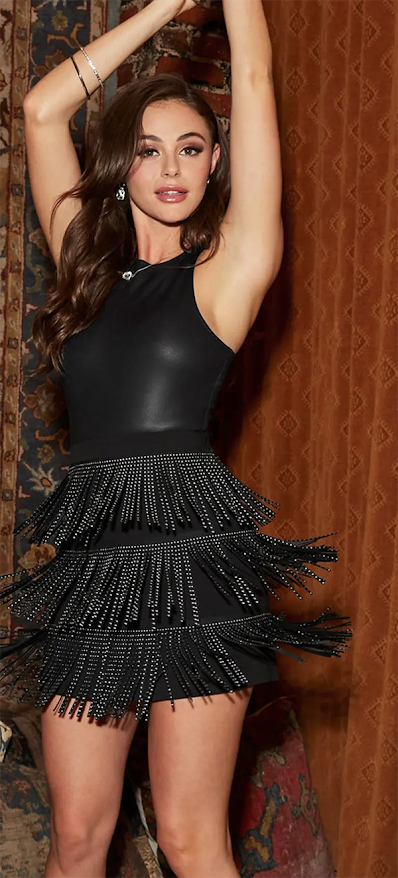 |
| Wearing Bebe |
 |
| @ungendered-01 |
By Paula Gaikowski
The old Maine farmhouse stood silent in its corner of the world. Its hidden treasure lay dormant, tucked away from the prying eyes of the world, forgotten by those who had once cherished it, the box, a piece of personal history lost to memory.
Years turned into decades and the farmhouse continued to guard its secret. Perhaps it was stashed away in a dusty attic concealed in the darkness of an abandoned room or relegated to the depths of a basement corner. As the seasons changed and generations passed, the box's significance faded into obscurity, its story locked away waiting for the right moment to resurface.
Then one fateful day, the farmhouse's secret was revealed. The box, once cherished and hidden, found itself amidst the bustle of a church yard sale. Tossed aside as just another forgotten box of stuff, it waited patiently for someone to recognize its value beyond its worn exterior. And that someone, a person who understood the emotions and struggles behind the box, would breathe life back into this long-lost treasure, ensuring that the story it held within would be told once more.
In a small Maine town, I was volunteering at out Labor Day yard sale. This annual event draws donations from across the community and it was here that I discovered an unusual vestige of the past, tucked away amongst the numerous boxes of items on display.
Among the treasures and memorabilia, my eyes were drawn to an old wooden box, its weathered exterior hinting at years of stories held within. The box had once been secured with a padlock, a safeguard for its precious contents. As I opened it, an assortment of women’s clothing, large sized high heels, foundation garments, stockings, old lipstick, makeup brushes, and most notably, a wig, greeted my eyes.
As femulators, many of us have had creative hiding places for our clothes and feminine accessories. To coin a phrase, it takes one to know one. Other persons, my fellow volunteers, just saw an old box of clothing. But to me, it was a guarded collection that seemed to whisper secrets of a life lived in shadows, far from the prying eyes of the world.
The clothing, perfectly preserved from the 1960s, was a heartbreaking testament to the struggles and the identity of its previous owner. As a transgender person, I couldn’t help but feel an immediate connection, a sense of camaraderie with the individual who had cherished these possessions. It was as if their silent history resonated with my own journey of self-discovery and acceptance.
The 1960s in Maine, like much of America, was a time of established social conservatism. For transgender individuals, it meant navigating a world filled with secrecy, guilt and fear. Each time this mysterious figure slipped into these clothes, applied makeup and donned that wig, it must have been a courageous act of self-expression, a defiance of the norms of their era.
What went unsaid within that wooden box was the incredible courage it took to maintain this hidden collection. I pictured this person in the solitude of a cold and dark Maine winter night seeking solace and identity in the sanctuary of her secret world.
Though separated by decades, I felt an undeniable connection to the owner of these belongings. I longed to reach back in time and offer a message of understanding, support and acceptance. Regrettably, all I could do was silently pledge to remember to honor and ensure that the memory of this mysterious figure endured.
In a world that has made substantial progress in embracing diversity and inclusion, this discovery served as a poignant reminder of how far we have come. It also underscored the importance of continuing to advocate for the rights and dignity of transgender individuals today.
As I reflect on this noteworthy encounter, I am reminded that history often speaks to us in whispers. Sometimes it takes something as simple as an old box of clothes to bridge the gap between generations, kindle empathy and ensure that the struggles and triumphs of those who paved the way are not forgotten.
In this silent connection, I find hope and a solemn promise that our collective journey toward understanding, acceptance and love for all will persist, leaving no one behind and preserving the memories of those who, against all odds, dared to be themselves.
 |
| Wearing Rue La La |
| Sam Brown and Darren Trumeter femulating on a 2007 episode of television’s The Whitest Kids U'Know. |
Last week, I was told that my wife would be coming home today. Yesterday, I was told that she needed more therapy and will not be coming home today. I agree with the therapists that she is not good to come home yet and more therapy will help, but we are all disappointed that she is not home by now. Thus, I am a bachelorette for another week.
UPDATE: After my first cup of coffee kicked in this morning, I noticed the facial similarities between the Femulate Her Rue La La model and Femulator Gail below. I wonder if they are related. Maybe the model is Gail’s grandson!
 |
| Wearing Rue La La |
 |
| Gail from New York, circa 1961 |
By Cathy Laura Peterson
As I read Paula Gaikowski's “Tomboys and Sissies,” it was so true for me as well, but also quite poignant. Growing up in the ’50s, ’60s and into the ’70s with two older sisters, a younger sister, our divorced mother, all living with our twice divorced Aunt Catherine, let’s just say I was dressed up a lot as my older sisters decided (dictated?) all of our playtime at home.
My earliest memories are about age four and being in dresses and slips but with my own boy underwear. Our mother worked Friday-Saturday-Sunday as a grocery clerk, so dress-up games occurred after she left.
Our mother’s bedroom was plain and boring. But all four of us dressed up for elaborate games of beauty pageant, school, hospital, beauty parlor or house including going to our Aunt in her lavish, ultra feminine bedroom (think Victorian British country home, flowers, lace, doilies, rugs, lamps, China tea sets, chest of drawers, three-mirror vanity table, elegant four-post bed).
Her response seeing me in dresses was always positive, so along with my three sisters, all I knew was this game is “okay.” And it was Aunt Catherine who first noticed I didn't have on lace tights like my sisters and emphatically said I should and also have “pretty panties” with tights like my sisters, who were happy to do oblige and of course, I simply complied. Again, it was confirmed and was “okay.”
Auntie was usually smoking a cigarette and reading in her big wingback flowered linen chair wearing foundation garments under a sheer, lacy flowered floor-length robe. She would also dote on each of us at her gorgeous three-mirror vanity table, where we could each choose clip-on earrings from her vast collection. Then she did lipstick for us and a spritz of perfume from a crystal decanter with the beaded spray bulb. She or my sisters put my hair up in a pony tail or pigtails with ribbons and plastic clip-in barettes. Again, all positive reinforcements, so I got very comfortable being dressed almost all weekend.
Catherine always warned I must be “back in your boy clothes before your mother sees you,” so that’s what we always planned for. But I clearly remember the day our mother left work early and walked into our kitchen around noon to find the four of us all in dresses eating lunch with our Aunt. Her reaction was quite negative, she used the word “sissy” and “pantywaist” in her outrage and took me by the wrist to the living room where I was derided with words like “embarrassing,” “prissy,” “wimpy,” “humiliating” and “Why are you doing this to me?” It was no longer “okay.”
Thankfully, Catherine intervened. My sisters sat with me as we watched and listened to a heated debate between these two women and it was our Aunt who seems to have won the argument with words I remember: “It’s harmless,” “Let them have some fun,” “Why should you care,” “You could use some fun in your sad life,” “There’s not much else to do at home,” “They’re all so happy when they play like this” and of course, “He likes it” and “Look at how cute he looks.” Were we back to “okay?”
That particular day ended with an uneasy truce between us kids and our mother as our Aunt reminded our mother “remember, I took you and your kids in and you’re living in my house.” From then on dressing up was always okay, mostly when mother was at work, but now there was license to be dressed up when she was home, too.
Our Aunt would say, “She’ll just have to deal with it.” Our mother was already quiet, depressed, solemn and distant since her divorce. From then on whenever she saw me fully dressed, she just had a blank expression, no emotion and I guess she tolerated it.
Catherine continued to be an active supporter of dress up all the way through my elementary school years and into junior high school. When she hugged me after earrings, lipstick and perfume, I can still see her smile and say, “Are you my little Cathy?” or “How’s my little Cathy?” as I’ve been since.
Like Paula, I knew very well that the kids at school, my teachers and neighbors would never approve of me looking and being so feminine. And I also wondered why two girls I knew were allowed to be classic tomboys very much like Scout in the Atticus Finch home. It seemed unfair that they could be very boyish not only at home but also out in public and there was seemingly nothing very negative they had to deal with. So if there were tomboys, why were there not also janegirls or something similar?
Many cold-snowy winter nights, all four of us were in flannel nighties with fuzzy slippers eating Jiffy Pop watching TV and that was “okay.”
In my school, I used to imagine being in a reading circle with a few girls and wearing a cute dress like them with a full slip, panties and tights, and everyone would be “okay” with that just like the two tomboys wearing jeans, sneakers, boyish t-shirts, maybe a ball cap and very short hair in what was called a “pixie cut.”
The contrast of tomboy and sissy continued into junior high school as I moved right into my older sisters’ training bras and shorter skirts and dresses, old garter belts with stockings or those new pantyhose, as I grew out my hair into a classic “shag” style for teenaged boys, onto my shoulders with bangs, which could easily look very girly/sissy.
I still saw all kinds of tomboys freely out and about at school and in town, but society circa 1975 still had no place for sissies like me, who were publicly derided as “transvestites.” So I continued to dress at home, even without my older sisters, but with my younger sister and our Aunt seeing me and our ambivalent mother just had to go a long with it.
Now in 2023, I go out into public all the time as Cathy, a middle-aged appropriate woman and societal norms in LA provide lots of freedom, acceptance and understanding 50 years after being a “sissy.”
 |
| Wearing Nanette by Nanette Lepore |
 |
| Andre Vasha |

 |
| Wearing Cynthia Rowley |
 |
| Willem Dafoe femulating in the 1999 film The Boondock Saints. Thank you Lynn Jones for this femulation alert. |
By J.J. Atwell
Hello again
It’s JJ again! Yes, there is more Stuff. I’m happy you continue to find this column thought-provoking. Let's get on with it today by talking about moisturizing and sunscreen.
Moisturizing
I’m a big convert to moisturizing. Being older, my skin has been through a lot including long sessions tanning at the beach or on the golf course. I really never thought about taking care of it. I go to a dermatologist regularly and I don’t have any serious issues. But I’m getting more concerned about my skin.
So now I moisturize my face twice a day, once in the morning and before going to bed. I also moisturize my arms and legs after showering. I especially love the feeling of my freshly shaved and moisturized legs. So nice and smooth.
But the constant reiteration of the importance of sunscreen is starting to penetrate. Hopefully my reminder here will encourage some of you to start using it regularly.
Sunscreen
At my regular dermatologist appointments and my visits to a spa for facials, they remind me about the importance of sunscreen. Let’s be clear; there is a difference between moisturizing and using sunscreen since not all moisturizers include sun protection. Sunscreens are measured in “SPF,” so look for that number when buying your moisturizer.
Also consider where and when you’ll be moisturizing. There may not be a need for an SPF in your moisturizer when you use it before bed. But when you get up in the morning, that’s when you should be picking up the moisturizer that has an SPF preferably SPF 20 or greater.
I’ll be back
OK, so I think I’ve given you enough stuff to think about. I hope you enjoyed this installment! As before, comments are welcome either here on the blog or by email to Jenn6nov at-sign gmail dot com . JJ is always looking for more stuff!
 |
| Wearing Black Halo |
 |
| Andrew Garfield femulating in Arcade Fires’ music video for We Exist. Click here to view this video on YouTube. |
 |
| Wearing Halston |
 |
| Male beauty pageant contestants in the 1968 film documentary The Queen. View this film on YouTube by clicking here. |
 |
| Wearing Ann Taylor |
 |
| Billy Crystal en femme on television’s Soap. You can view this crossdressing on YouTube by clicking here. |